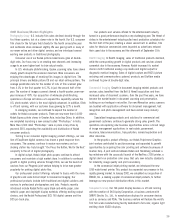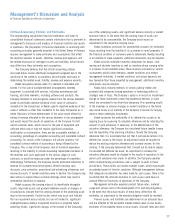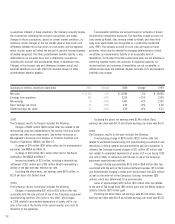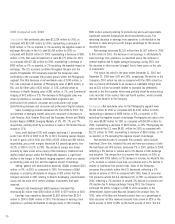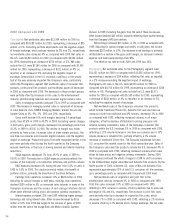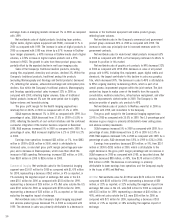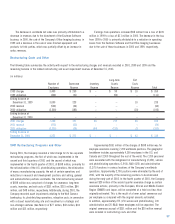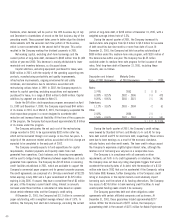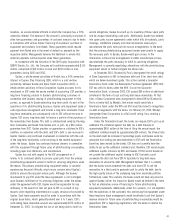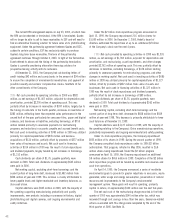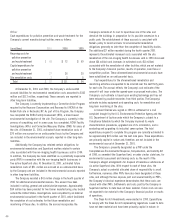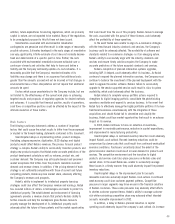Kodak 2001 Annual Report Download - page 37
Download and view the complete annual report
Please find page 37 of the 2001 Kodak annual report below. You can navigate through the pages in the report by either clicking on the pages listed below, or by using the keyword search tool below to find specific information within the annual report.
35
increase in film sales to the entertainment industry reflects the recovery
of the motion picture film industry from the softness of a year ago.
Net worldwide sales of film products for the professional consumer,
which include color negative, color reversal and black-and-white film,
decreased 10% during 2000 as compared with 1999. The decrease in
sales of professional consumer film reflects a decrease in volume and
pricing pressures in most product groups, partially offset by an increase in
sales volume within the color negative product group. The net downward
trend in the sale of professional film products existed throughout 2000 and
is due principally to the ongoing digital capture substitution.
Net worldwide sales of the Company’s consumer color paper
decreased 3% in 2000 as compared with 1999, reflecting lower prices
and a negative foreign exchange impact, which were partially offset by
an increase in volume. Net sales of color paper in the U.S. increased 1%,
as 3% volume increases outweighed the lower prices. Net sales outside
the U.S. decreased 5%, as increased volumes could not offset lower
price/mix and negative exchange movements. Net worldwide sales of
sensitized paper for the professional consumer decreased 10% in 2000
as compared with 1999, reflecting declines due to volume, price and
exchange of 2%, 5% and 3%, respectively.
Revenues from the Company’s on-site and overnight photofinishing
equipment, products and services increased 3% in 2000 as compared
with 1999, primarily due to increased placements of minilabs during the
year.
Net worldwide sales of the Company’s consumer digital cameras
increased 26% in 2000 as compared with 1999, reflecting a 72%
increase in unit volumes, offset by declines in both price and exchange.
The lower sales prices reflect the competitiveness in this business.
Consumer digital camera sales in the U.S. increased 17%, while sales
outside the U.S. increased 38%. The increase in sales of digital cameras
both inside and outside the U.S. reflect higher volumes, offset partially by
lower prices. As of the end of 2000, the Company had the number three
consumer market share position in the U.S. The net worldwide sales of
digital cameras for the professional consumer decreased 37% in 2000 as
compared with 1999, reflecting decreases in volume, price and exchange.
The net worldwide sales of the Company’s inkjet photo paper
increased 34% in 2000 as compared with 1999, reflecting significant
volume increases over 1999 levels. Worldwide sales of thermal paper for
the professional consumer remained flat, reflecting a decrease of 1% in
2000 as compared with 1999.
The Company continued its strong focus on the consumer imaging
digital business, which includes the picture maker kiosks/media and
consumer imaging digital products and services revenue from picture CD,
“You’ve Got Pictures,” Print@Kodak and PictureVision. Revenues from the
placement of picture maker kiosks and the related media increased 17%
in 2000 as compared with 1999, representing an increase in both
equipment and thermal media sales of 19% and 15%, respectively. This
trend in increased media usage reflects the Company’s focus on creating
new sales channels and increasing the media burn per kiosk. As of the
end of 2000, the number of Kodak picture maker kiosk placements was
in excess of 29,000, reflecting an increase of 6,000 over the 1999 level.
Revenue from consumer digital services increased 103% in 2000 as
compared with 1999. In addition, the Company experienced an increase
in digital penetration in its Qualex wholesale labs. The average digital
penetration rate for the number of rolls scanned averaged 4.1% for the
year.
The sales of the Motion Analysis Systems Division and The Image
Bank in 1999 contributed to the decrease in revenues in 2000 as
compared with 1999. As a result of these business sales, Photography
segment sales decreased $105 million in 2000 as compared with 1999.
Other product groups contributing to the net decrease in worldwide
Photography segment sales include CD Media, which experienced a sales
decrease of 44% in 2000 as compared with 1999.
The gross profit margin for the Photography segment was 40.1% in
2000 as compared with 43.8% in 1999. The 3.7 percentage point
decrease in gross margin is primarily attributable to continued lower
effective selling prices across virtually all product groups, including the
Company’s core products of traditional film, paper, and digital cameras,
unfavorable product mix and adverse exchange movements.
SG&A expenses decreased 6% in 2000 as compared with 1999,
reflecting the benefits of the Company’s cost-reduction efforts and a $12
million charge recorded in SG&A in 1999 relating to business exits. As a
percentage of sales, SG&A decreased from 20.5% in 1999 to 19.3% in
2000. SG&A, excluding advertising, decreased 8%, representing 12.9% of
sales in 2000 and 13.9% of sales in 1999. R&D remained flat as a
percentage of sales at 5.6%.
Earnings from operations decreased $279 million, or 16%, from
$1,709 million in 1999 to $1,430 million in 2000, reflecting the slightly
lower sales and the 3.9 percentage point decrease in the gross profit
margin, offset partially by charges taken in 1999 associated with the exit
of the sticker print kiosk product line, the write-off of the Calcomp
investment, and the decrease in SG&A expenses described above. Net
earnings decreased $227 million, or 18%, from $1,261 million in 1999 to
$1,034 million in 2000, reflecting lower earnings from operations and
$120 million of other income in 1999 relating to the sale of The Image
Bank and the Motion Analysis Systems Division.
Health Imaging Net worldwide sales for the Health Imaging segment
were $2,220 million for 2000 as compared with $2,159 million for 1999,
representing an increase of $61 million, or 3% as reported, or 6%
excluding the negative impact of exchange. Health Imaging net sales in
the U.S. were $1,067 million for 2000 as compared with $984 million for
1999, representing an increase of $83 million or 8%, while net sales
outside the U.S. were $1,153 million for 2000 as compared with $1,175
million for 1999, representing a decrease of $22 million, or 2% as
reported, or an increase of 4% excluding the negative impact of


